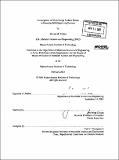Investigation of short-range surface forces to develop self-organizing devices by Steven M. Tobias.
Author(s)
Tobias, Steven M., 1980-
DownloadFull printable version (3.787Mb)
Other Contributors
Massachusetts Institute of Technology. Dept. of Materials Science and Engineering.
Advisor
Yet-Ming Chiang.
Terms of use
Metadata
Show full item recordAbstract
Force spectra from atomic force microscopy were used to verify surface energy components of indium tin oxide and mesocarbon microbeads. These materials were selected based on spectroscopic and thermodynamic parameters to be used in self-organizing devices. Estimates for surface energy were based on the van der Waals contribution described by Lifshitz theory and the polar contribution described by electron donor and acceptor components. This new type of device assembly process can be self-organizing based on the principle of like particle attraction and dissimilar particle repulsion. A thin insulting barrier could be inserted at the interface between two different types of particles, enabling junction formation. The criteria necessary to create a device based on surface energy components was specified.
Description
Thesis (S.M.)--Massachusetts Institute of Technology, Dept. of Materials Science and Engineering, 2005. Leaf 69 blank. Includes bibliographical references (leaves 65-68).
Date issued
2005Department
Massachusetts Institute of Technology. Department of Materials Science and EngineeringPublisher
Massachusetts Institute of Technology
Keywords
Materials Science and Engineering.